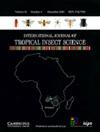Potential side effects of the interaction between Phthorimaea absoluta parasitoids: the exotic Dolichogenidea gelechiidivoris and the native Bracon nigricans
IF 1.2
4区 农林科学
Q3 ENTOMOLOGY
International Journal of Tropical Insect Science
Pub Date : 2023-11-06
DOI:10.1007/s42690-023-01052-0
引用次数: 0
Abstract
Abstract The coexistence and efficiency in pest control of introduced and native parasitoids can be challenging. Continuous observations of the cohabitation of parasitoid species could confirm the persistence of the introduced parasitoid in the ecosystem under co-existence scenarios. This study provides an example of such a co-existence for biocontrol of the invasive pest, Phthorimaea absoluta (Meyrick) (Lepidoptera: Gelechiidae). Two parasitoids, the introduced endoparasitoid Dolichogenidea gelechiidivoris (Marsh) (Hymenoptera: Braconidae) and the native ectoparasitoid Bracon nigricans Szépligeti (Hymenoptera: Braconidae) were released in cages containing a tomato plant infested with P. absoluta . Parasitism and killing rate of P. absoluta by both parasitoid species, and the parasitoid and P. absoluta population were monitored weekly. The parasitoid species coexisted for seven weeks in the experimental units. Parasitism by D. gelechiidivoris was significantly affected by the presence of B. nigricans, with 73% and 22% parasitism in the absence and presence of B. nigricans, respectively. Parasitism by B. nigricans was not affected by its co-existence with D. gelechiidivoris . The number of D. gelechiidivoris adults increased eight-fold in five weeks in the absence of B. nigricans , while less than the initial number of adults were present in co-existence with B. nigricans . The P. absoluta infestation declined from the fifth week to 98% lesser than the control in all the treatments, either D. gelechiidivoris or B. nigricans as standalone treatments, as well as in combination. Since B. nigricans negatively affected D. gelechiidivoris population growth, releases of this introduced parasitoid should be considered with caution in areas where B. nigricans occurs.绝对拟寄生物的潜在毒副作用:外来寄生物与本土寄生物黑松的相互作用
摘要引进类寄生蜂和本地类寄生蜂的共存和防治效率是一个具有挑战性的问题。对拟寄生物群落的连续观测可以证实在共生条件下引入的拟寄生物在生态系统中的持久性。本研究为入侵害虫绝对灰蝇(Phthorimaea absoluta (Meyrick))的生物防治提供了这种共存的范例。将引进的内寄生蜂黑斑小蜂(膜翅目:小蜂科)和本地的外寄生蜂黑斑小蜂(膜翅目:小蜂科)2只寄生蜂放生在侵染绝对白腹小蜂的番茄植株笼内。每周监测两种寄生蜂、寄生蜂和绝对寄生蜂的寄生率和杀虫率。拟寄生物在实验单元中共存7周。黑僵菌的存在显著影响黑僵菌的寄生率,无黑僵菌和有黑僵菌时,黑僵菌的寄生率分别为73%和22%。黑小黑蜂的寄生不受其与离巢小黑蜂共存的影响。在没有黑僵菌的情况下,五周内,黑僵菌成虫的数量增加了8倍,而与黑僵菌共存的成虫数量则少于最初的数量。在所有处理中,无论是单独处理还是联合处理,绝对白僵菌的侵染率从第5周开始下降到比对照低98%。由于黑僵菌对黑僵菌种群增长产生负面影响,在黑僵菌发生的地区,应谨慎考虑这种引入的寄生蜂的释放。
本文章由计算机程序翻译,如有差异,请以英文原文为准。
求助全文
约1分钟内获得全文
求助全文
来源期刊

International Journal of Tropical Insect Science
ENTOMOLOGY-
CiteScore
2.40
自引率
8.30%
发文量
212
期刊介绍:
International Journal of Tropical Insect Science is the only journal devoted exclusively to the latest research in tropical and sub-tropical insect science. Each issue brings you original, peer-reviewed research findings on tropical insects and related arthropods, with special emphasis on their environmentally benign and sustainable management.
The Journal"s scope includes arthropod ecology and biodiversity, ethno-entomology, arthropod taxonomy, integrated pest and vector management, and environmental issues. The Journal publishes research papers, short communications and scientific notes. The Journal also includes reports of meetings and obituaries of prominent scientists, book reviews, and review and mini-review articles that are normally submitted at the invitation of the Editors.
 求助内容:
求助内容: 应助结果提醒方式:
应助结果提醒方式:


